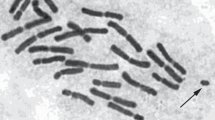Summary
The cytology of four species ofStriga, viz., S. densiflora, S. euphrasioides,S. lutea andS. orobanchoides is described. The chromosome numbers have been found to ben = 20 and 2n = 40 in all the four species.
The basic number of chromosomes of the genus is shown to be eight. Based on theoretical considerations it is suggested that in using evidence from secondary associations the most frequent type of association should be taken as indicating the basic number.
Similar content being viewed by others
Literature Cited
Catcheside, D. G. “Secondary pairing inBrassica oleracea,”Cytologia, Fujii Jub. Vol., 1937,1, 366–78.
Lawrence, W. J. C. “The secondary association of chromosomes,” —, 1931,2, 352–84.
Raghavan, T. S., and Srinivasan, V. K. “Studies in the Scrophulariaceæ. l. The cytology ofAngeIonia grandiflora C. Morr. and some related genera,” —, 1940,11, 37–54.
Srinath, K. V. “Morphological and cytological Studies in the GenusCalceolaria. Part II. Meiosis in diploid and aneuploidCalceolarias,” —, 1940,10, 467–91.
Author information
Authors and Affiliations
Rights and permissions
About this article
Cite this article
Kumar, L.S.S., Abraham, A. Cytological studies in indian parasitic plants. Proc. Indian Acad. Sci. 14, 509–516 (1941). https://doi.org/10.1007/BF03051466
Received:
Issue Date:
DOI: https://doi.org/10.1007/BF03051466




